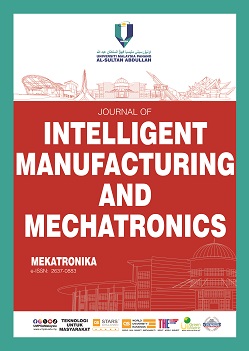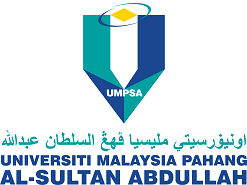Evaluating the Impact of Coolants on Tool Wear and Surface Quality in Ball End Milling: A Sustainability Performance Assessment
DOI:
https://doi.org/10.15282/mekatronika.v6i2.11398Keywords:
Cutting Fluids, Ball End Milling, Coolant Conditions, Tool Wear, Sustainability IntegrationAbstract
The role of cutting fluids in machining operations is crucial, impacting productivity, tool lifespan, and work quality. An experimental investigation was conducted on ball end milling of AISI 1040 steel using uncoated HSS tools under various coolant conditions and milling modes. This research encompassed four coolant conditions: dry, mist, 4% coolant concentration, and 8% coolant concentration, with constant cutting parameters. Machining performance was assessed based on tool wear and surface roughness. Results indicate a significant influence of coolant conditions on machining performance and surface quality. Mist coolant in down milling mode exhibited superior performance in terms of tool wear and average surface roughness (0.09mm and 0.462μm, respectively), followed closely by mist coolant in up milling mode, 8% coolant concentration, and lastly, 4% coolant concentration under up milling mode. This research not only evaluated the impact of different cooling conditions but also focused on integrating sustainability into the machining process. It is expected that the regression analysis will develop a model predicting how sustainability and machining attributes interact. This model will demonstrate the benefits of incorporating sustainability parameters into machining conditions, providing valuable insights for optimising processes with environmental and societal considerations. By creating a comprehensive interaction model, the research is anticipated to address practical aspects of coolant performance and support informed decision-making, ultimately enhancing both machining performance and sustainable manufacturing practices.References
[1] Cheng K (2009) Machining Dynamics. Springer London, London
[2] Shokrani A, Biermann D (2020) Advanced Manufacturing and Machining Processes. Journal of Manufacturing and Materials Processing 4:102. https://doi.org/10.3390/jmmp4040102
[3] Deshpande V, Jyothi PN (2022) A Review on Sustainable Eco-friendly Cutting Fluids. Journal of Sustainability and Environmental Management 1:306–320. https://doi.org/10.3126/josem.v1i2.45383
[4] Kumar P, Jain AK, Chaurasiya PK, et al (2022) Sustainable Machining Using Eco-Friendly Cutting Fluids: A Review. Advances in Materials Science and Engineering 2022:1–16. https://doi.org/10.1155/2022/5284471
[5] Salur E, Kuntoğlu M, Aslan A, Pimenov DY (2021) The Effects of MQL and Dry Environments on Tool Wear, Cutting Temperature, and Power Consumption during End Milling of AISI 1040 Steel. Metals (Basel) 11:1674. https://doi.org/10.3390/met11111674
[6] Singh J, Gill SS, Dogra M, et al (2022) State of the art review on the sustainable dry machining of advanced materials for multifaceted engineering applications: progressive advancements and directions for future prospects. Mater Res Express 9:064003. https://doi.org/10.1088/2053-1591/ac6fba
[7] Katam AK, Mohanty RC, Kolakoti A (2023) The role of bio-based cutting fluids for sustainable manufacturing and machining processes: A holistic review. Mechanical Engineering for Society and Industry 3:166–180. https://doi.org/10.31603/mesi.10680
[8] Swain S, Patra SK (2023) Advancements in cooling techniques and its impact on machining: A review. Mater Today Proc. https://doi.org/10.1016/j.matpr.2023.02.438
[9] Wajiha Tasnim Urmi, Md Mustafizur Rahman, Wahaizad Safiei, et al (2022) Effects of Minimum Quantity Lubrication Technique in Different Machining Processes - A Comprehensive Review. Journal of Advanced Research in Fluid Mechanics and Thermal Sciences 90:135–159. https://doi.org/10.37934/arfmts.90.2.135159
[10] Wang L, Cai W, He Y, et al (2023) Equipment-process-strategy integration for sustainable machining: a review. Frontiers of Mechanical Engineering 18:36. https://doi.org/10.1007/s11465-023-0752-4
[11] Fernando R, Gamage J, Karunathilake H (2022) Sustainable machining: environmental performance analysis of turning. International Journal of Sustainable Engineering 15:15–34. https://doi.org/10.1080/19397038.2021.1995524
[12] Abellán-Nebot J V., Vila Pastor C, Siller HR (2024) A Review of the Factors Influencing Surface Roughness in Machining and Their Impact on Sustainability. Sustainability 16:1917. https://doi.org/10.3390/su16051917
[13] Soori M, Arezoo B (2024) The effects of coolant on the cutting temperature, surface roughness and tool wear in turning operations of Ti6Al4V alloy. Mechanics Based Design of Structures and Machines 52:3277–3299. https://doi.org/10.1080/15397734.2023.2200832
[14] Rajmohan T, Kalyan Chakravarthy VV, Nandakumar A, Satish Kumar SD (2020) Eco Friendly Machining Processes for Sustainability - Review. IOP Conf Ser Mater Sci Eng 954:012044. https://doi.org/10.1088/1757-899X/954/1/012044
[15] Selamat SN, Nor NHM, Rashid MHA, et al (2017) Review of CO2 Reduction Technologies using Mineral Carbonation of Iron and Steel Making Slag in Malaysia. J Phys Conf Ser 914:012012. https://doi.org/10.1088/1742-6596/914/1/012012
[16] Halim NHA, Haron CHC, Ghani JA, Azhar MF (2019) Tool wear and chip morphology in high-speed milling of hardened Inconel 718 under dry and cryogenic CO2 conditions. Wear 426–427:1683–1690. https://doi.org/10.1016/j.wear.2019.01.095
[17] Pereira O, Celaya A, Urbikaín G, et al (2020) CO2 cryogenic milling of Inconel 718: cutting forces and tool wear. Journal of Materials Research and Technology 9:8459–8468. https://doi.org/10.1016/j.jmrt.2020.05.118
[18] Dhar NR, Kamruzzaman M, Ahmed M (2006) Effect of minimum quantity lubrication (MQL) on tool wear and surface roughness in turning AISI-4340 steel. J Mater Process Technol 172:299–304. https://doi.org/10.1016/j.jmatprotec.2005.09.022
[19] Gupta MK, Niesłony P, Sarikaya M, et al (2023) Studies on Geometrical Features of Tool Wear and Other Important Machining Characteristics in Sustainable Turning of Aluminium Alloys. International Journal of Precision Engineering and Manufacturing-Green Technology 10:943–957. https://doi.org/10.1007/s40684-023-00501-y
[20] Wang X, Li C, Zhang Y, et al (2020) Vegetable oil-based nanofluid minimum quantity lubrication turning: Academic review and perspectives. J Manuf Process 59:76–97. https://doi.org/10.1016/j.jmapro.2020.09.044
[21] Turan FM, Johan K (2016) Assessing sustainability framework of automotive related industry in the Malaysia context based on GPM P5 standard. ARPN Journal of Engineering and Applied Sciences 11:7606-7611
[22] Sahimi NS, Turan FM, Johan K (2017) Development of Sustainability Assessment Framework in Hydropower sector. IOP Conf Ser Mater Sci Eng 226:012048. https://doi.org/10.1088/1757-899X/226/1/012048
[23] Turan FM, Johan K, Nor NHM (2016) Criteria Assessment Model for Sustainable Product Development. In: IOP Conference Series: Materials Science and Engineering, 160:0124. https://doi.org/10.1088/1757-899X/160/1/012004
[24] Wan Lanang WNS, Turan FM, Johan K (2017) Systematic Assessment Through Mathematical Model for Sustainability Reporting in Malaysia Context. In: IOP Conference Series: Materials Science and Engineering, 226:012049. https://doi.org/10.1088/1757-899X/226/1/012049
[25] Turan FM, Johan K, Lanang WNSW, Nor NHM (2016) Development of Systematic Sustainability Assessment (SSA) for the Malaysian Industry. In: IOP Conference Series: Materials Science and Engineering, 160:012047. https://doi.org/10.1088/1757-899X/160/1/012047
[26] Sahimi NS, Turan FM, Johan K (2018) Framework of Sustainability Assessment (FSA) method for manufacturing industry in Malaysia. In: IOP Conference Series: Materials Science and Engineering, 342:012079. https://doi.org/10.1088/1757-899X/342/1/012079
[27] Salonitis K, Stavropoulos P (2013) On the Integration of the CAx Systems Towards Sustainable Production. Procedia CIRP 9:115–120. https://doi.org/10.1016/j.procir.2013.06.178
[28] Bunse K, Vodicka M, Schönsleben P, et al (2011) Integrating energy efficiency performance in production management – gap analysis between industrial needs and scientific literature. J Clean Prod 19:667–679. https://doi.org/10.1016/j.jclepro.2010.11.011
[29] Davé A, Salonitis K, Ball P, et al (2016) Factory Eco-Efficiency Modelling: Framework Application and Analysis. Procedia CIRP 40:214–219. https://doi.org/10.1016/j.procir.2016.01.105
[30] Davé A, Ball P, Salonitis K (2017) Factory Eco-Efficiency Modelling: Data Granularity and Performance Indicators. Procedia Manuf 8:479–486. https://doi.org/10.1016/j.promfg.2017.02.061
[31] Saxena P, Stavropoulos P, Kechagias J, Salonitis K (2020) Sustainability Assessment for Manufacturing Operations. Energies (Basel) 13:2730. https://doi.org/10.3390/en13112730
[32] López de Lacalle LN, Angulo C, Lamikiz A, Sánchez JA (2006) Experimental and numerical investigation of the effect of spray cutting fluids in high speed milling. J Mater Process Technol 172:11–15. https://doi.org/10.1016/j.jmatprotec.2005.08.014
[33] Kishawy HA, Dumitrescu M, Ng E-G, Elbestawi MA (2005) Effect of coolant strategy on tool performance, chip morphology and surface quality during high-speed machining of A356 aluminum alloy. Int J Mach Tools Manuf 45:219–227. https://doi.org/10.1016/j.ijmachtools.2004.07.003
[34] John A. Schey (2000) Introduction to Manufacturing Processes, 3rd ed. McGraw-Hill
[35] Steve F. Krar, Arthur R. Gill, Peter Smid, et al (2024) Technology Of Machine Tools, 9th ed. McGraw Hill
[36] Liu N, Loftus M, Whitten A (2005) Surface finish visualisation in high speed, ball nose milling applications. Int J Mach Tools Manuf 45:1152–1161. https://doi.org/10.1016/j.ijmachtools.2004.12.007
[37] Aikhuele DO, Turan FM, Odofin SM, Ansah RH (2017) Interval-valued Intuitionistic Fuzzy TOPSIS-based model for troubleshooting marine diesel engine auxiliary system. Transactions of the Royal Institution of Naval Architects Part A: International Journal of Maritime Engineering 159:. https://doi.org/10.3940/rina.ijme.2016.al.402
[38] Aikhuele DO, Turan FM (2016) A Hybrid Fuzzy Model for Lean Product Development Performance Measurement. In: IOP Conference Series: Materials Science and Engineering, 114: 012048. https://doi.org/10.1088/1757-899X/114/1/012048
[39] Aikhuele DO, Turan FM (2018) A modified exponential score function for troubleshooting an improved locally made Offshore Patrol Boat engine. Journal of Marine Engineering and Technology 17:. https://doi.org/10.1080/20464177.2017.1286841
[40] Aikhuele DO, Turan FM (2016) Proposal for a Conceptual Model for Evaluating Lean Product Development Performance: A Study of LPD Enablers in Manufacturing Companies. In: IOP Conference Series: Materials Science and Engineering, 114:012047. https://doi.org/10.1088/1757-899X/114/1/012047
Downloads
Published
Issue
Section
License
Copyright (c) 2024 The Author(s)

This work is licensed under a Creative Commons Attribution-NonCommercial 4.0 International License.




